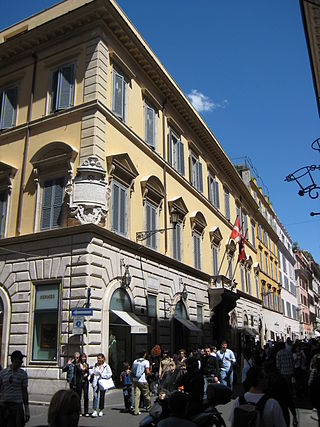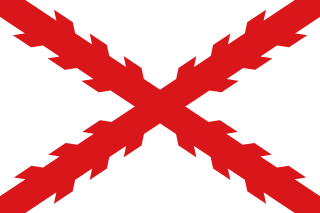
The Sovereign Military Order of Malta (SMOM), officially the Sovereign Military Hospitaller Order of Saint John of Jerusalem, of Rhodes and of Malta, and commonly known as the Order of Malta or the Knights of Malta, is a Catholic lay religious order, traditionally of a military, chivalric, and noble nature. Though it possesses no territory, the order is often considered a sovereign entity under international law.

The Militia Templi, also called the Order of the Poor Knights of Christ, is a lay order of the Roman Catholic Church.

Piazza Armerina is a comune in the province of Enna of the autonomous island region of Sicily, southern Italy.

Augusta is a town and comune in the province of Syracuse, located on the eastern coast of Sicily. The city is one of the main harbours in Italy, especially for oil refineries which are in its vicinity.

The history of Rhodes under the Order of Saint John lasted from 1310 until 1522. The island of Rhodes was a sovereign territorial entity of the Knights Hospitaller who settled on the island from Palestine and from Cyprus, where they did not exercise temporal power. The first Grand Master was the Frenchman Foulques de Villaret (1305–1319).

Palazzo Malta, officially named as the Magistral Palace, and also known as Palazzo di Malta or Palazzo dell'Ordine di Malta, is the more important of the two headquarters of the Sovereign Military Order of Malta, a Roman Catholic lay religious order and a sovereign subject of international law. It is located in Via dei Condotti, 68 in Rome, Italy, a few minutes' walk from the Spanish Steps, and has been granted extraterritoriality by the Italian Government. The Palace has been a property of the Order of Malta since 1630.

Villa del Priorato di Malta or Magistral Villa, located on the Aventine Hill in Rome, is one of the two institutional seats of the government of the Sovereign Military Order of Malta. Along with Magistral Palace, the estate is granted extraterritorial status by Italy. It also hosts the Grand Priory of Rome and the embassy of the Sovereign Order of Malta to Italy.

The Church of St. Mary of the Priory, also known as St. Mary on the Aventine, is the monastery church of the Priory of the Knights of Malta on the Aventine Hill in Rome, and is dedicated to the Blessed Virgin Mary.

Hospitaller Malta, known in Maltese history as the Knights' Period, was a de facto state which existed between 1530 and 1798 when the Mediterranean islands of Malta and Gozo were ruled by the Order of St. John of Jerusalem. It was formally a vassal state of the Kingdom of Sicily, and it came into being when Emperor Charles V granted the islands as well as the city of Tripoli in modern Libya to the Order, following the latter's loss of Rhodes in 1522. Hospitaller Tripoli was lost to the Ottoman Empire in 1551, but an Ottoman attempt to take Malta in 1565 failed.

The Casa dei Cavalieri di Rodi is a building in Rome. Sited in the ruins of the Forum of Augustus, it was built by the Knights Hospitaller at the end of the 13th century and since 1946 has been used by their successors, the Sovereign Military Order of Malta.

The Conspiracy of the Slaves was a failed plot by Muslim slaves in Hospitaller-ruled Malta to rebel, assassinate Grand Master Manuel Pinto da Fonseca and take over the island. The revolt was to have taken place on 29 June 1749, but plans were leaked to the order before it began; the plotters were arrested and most were later executed.

The Forni della Signoria was a bakehouse in Valletta, Malta. It was constructed in the late 16th century by the Order of St John, and it consisted of a number of bakeries which produced bread for the inhabitants of Valletta and the surrounding area, as well as for the Order's garrison and navy.

The Adragna family is an Italian noble house. The family ruled the territory of Altavilla in Sicily, Italy.

Italy and the colonization of the Americas was related to

The Casa dei Cavalieri di Malta is a historic building in the old town of Bitetto, in the Metropolitan City of Bari, Italy. The building is traditionally associated with the Knights Hospitaller, also known as the Knights of Malta.
The Association of Italian Knights of the Sovereign Military Order of Malta brings together the Knights and Ladies of the Sovereign Military Order of Malta of Italian nationality. It was founded in 1877 in Rome, it is currently based at the Casa dei Cavalieri di Rodi in the Piazza del Grillo, Rome.

San Giovanni di Malta, also known as San Giovanni del Tempio or San Giovanni dei Furlani, is a Roman Catholic church in the Castello sestiere of Venice, Italy, dedicated to John the Baptist. It is believed to have been established by the Knights Hospitaller sometime after 1187, although it is sometimes linked to the Knights Templar. The present building was constructed between 1498 and 1505, and it is located adjacent to a priory. The property was taken over by the state in 1806 and the church was closed in 1810, but in 1841 it was handed over to the Sovereign Military Order of Malta, who reopened the church in 1843.

Tripoli, today the capital city of Libya, was a presidio of the Spanish Empire in North Africa between 1510 and 1530. The city was captured by Spanish forces in July 1510, and for the next two decades it was administered as an outpost which fell under the jurisdiction of the Spanish Viceroy of Sicily. The city was granted as a fief to the Knights Hospitaller in 1530, and the latter ruled the city until 1551.

Tripoli, today the capital city of Libya, was ruled by the Knights Hospitaller between 1530 and 1551. The city had been under Spanish rule for two decades before it was granted as a fief to the Hospitallers in 1530 along with the islands of Malta and Gozo. The Hospitallers found it difficult to control both the city and the islands, and at times they proposed to either move their headquarters to Tripoli or to abandon and raze the city. Hospitaller rule over Tripoli ended in 1551 when the city was captured by the Ottoman Empire following a siege.















